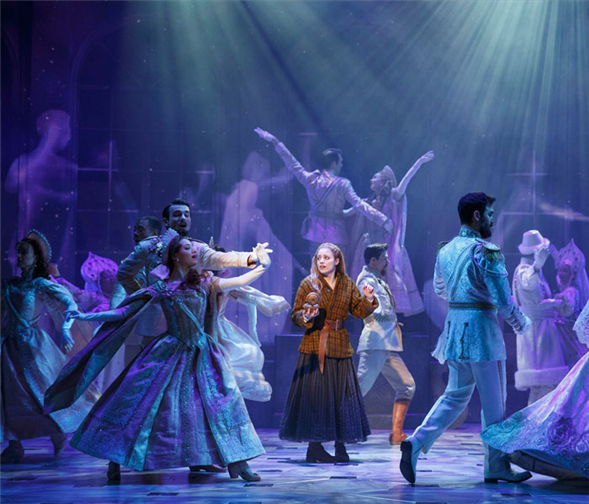Translate Page

Inside this Broadway's musical's projection design
---
Near the end of the first act of the Broadway musical Anastasia, three characters, filled with hope and excitement, take a train out of Russia heading for Paris.
It's quite a ride for them – and for the audience – in a production that highlights the latest in projection design.
The musical, based on the 1997 animated film and the live-action 1956 picture starring Ingrid Bergman and Yul Brynner, centers on Anya, a mysterious amnesiac who is enlisted by con men who wish to present her as the Grand Duchess Anastasia Nikolaevna of Russia. As legend has it, Anastasia is the only member of the Russian royal family who escaped murder by revolutionaries, so producing her could reap considerable rewards for shady characters.
Like the films, the stage show, which is now at the Broadhurst Theatre after appearing last year at Hartford Stage, tell a propulsive, emotional story. Aaron Rhyne's dynamic 3-D projections have proven vital to maintaining that energy. In the train scene, for instance, his work reflects the speed of the locomotive, the ever-changing countryside, and even the various perspectives of the characters as they flee Russia and try to reach Anastasia's grandmother in France.
At the beginning of the scene, Rhyne creates period maps, which act as guideposts for the journey. As the train leaves Russia, the projections gradually change as color and elements of springtime are introduced into the fast-moving surrounding scenery.
"The train sequence is built in a 3-D computer world," says Rhyne. "We took trees and plants and other visual elements that would literally be in the landscape of that ride to make the audience feel what it would be like if they were on that trip."
Soon after the train scene, the characters find themselves standing in a clearing on the outskirts of Paris. Anya (Christy Altomare) sings the song "Journey to the Past," which originally appeared in the animated film. (Like the score of this musical, the song was written by Stephen Flaherty and Lynn Ahrens.)
As Altomare hits the song's climactic top note, the scenery begins to move. The perspective changes as Anya ascends a hill, and soon a glittering view of Paris is revealed in the distance -- just as the orchestra strikes its final chord.
"But first we wait and give the moment to Christy," says Rhyne. "If we were to do [the reveal] a moment too early, we would be robbing her of her moment, and that moment is what fulfills the whole first part of the show. We need to see her live that."
It's a powerful sequence in the animated film, too "They were using hand-drawn animation, but we're using more dimensional, reality-based work for that same emotional effect," Rhyne says.
{Image1}
This demonstrates how projection design has evolved into a dynamic and vital element of a production. Creating the visual look for Anastasia was a collaborative one, Rhyne notes, and it included director Darko Tresnjak, set designer Alexander Dodge, and veteran lighting designer Donald Holder.
"We wanted to base things in reality and the architectural history of Imperial Russia and Paris at the time," he adds. "We also wanted to heighten it within the context of whatever was happening on stage. Everything has to feel alive."
He can add life to the quieter scenes as well. As he says, that involves "giving the sky little shifts of light, making the water move just a little, just enough to make it more dynamic but not steal focus. I always say, 'Let the audience look at it, have their eye take it in and let it fill the moment, and then go back to the story.'"
To develop his design, Rhyne began by placing Dodge's sets into a 3-D computer modal. "Then I reconfigured his set to create different rooms, breaking the walls open," he says. "For instance, for the ballroom, I extended the floor and built another back LED wall that appears to be dimensional. The hope is that you can't necessarily tell the difference between where the physical set ends and the projections begin. It looks like another wall came back, but it's just in another re-conceived place. It's still a piece that Alexander designed."
Another impressive effect is the creation of the show's "ghosts" — figures from Anya’s real or imagined past who emerge as she tries to recall a privileged life in Imperial Russia and, later, the massacre of the royal family.
"We created the ghosts by shooting the actors in a green screen set doing various movements and choreography, having them move very quickly at double-speed," Rhyne says. "Then we slowed it down in post-production, which gives everything a soft, ghosty quality. I'm weaving the ghosts in and out of the 'illusion' of scenery that's actually on video behind the set. It feels like the ghosts are coming from all levels, immersing us. It's really beautiful "
Asked about the ways this production is pushing him as an artist, he says, "There's a lot of shows on Broadway now that have projections. It's a common thing, but I think this is the most video ever used in a show. There's a lot of visual power that we hope will make people go, 'Oh, wow.' But I've got to make sure that it doesn't pull focus and that the story on stage is also being told. It's all about finding that balance."
To read about a student's experience at Anastasia, check out this post on TDF's sister site SEEN.
---
Follow Frank Rizzo at @ShowRiz. Follow TDF at @TDFNYC.
Top photo: Christy Altomare (center), cast members, and 'ghosts' in the Hartford Stage production. Photo by Joan Marcus.
TDF Members: Go here to browse our discounts for theatre, dance, and concerts.